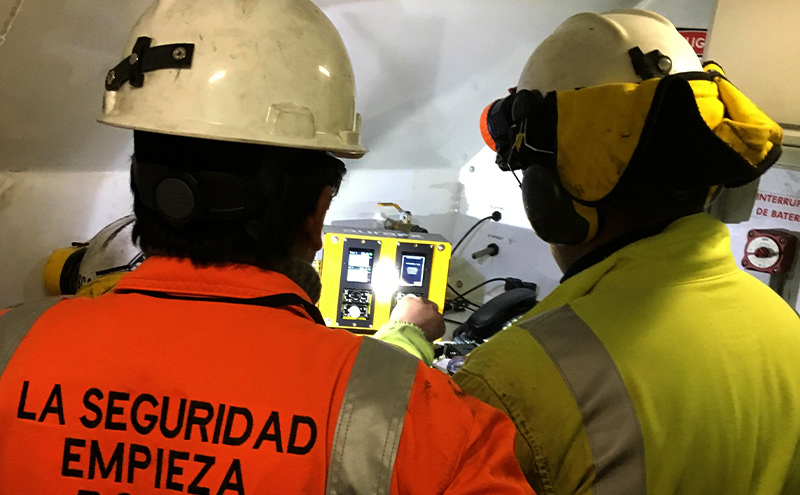Gas and environmental monitoring of gas levels in mining is essential. There are fixed and portable devices available to detect the concentration of gases within the atmosphere.
Fixed gas monitors can provide constant readings from a set location. It is recommended to distribute fixed gas monitors throughout a mine site or building. These site-wide warning systems relay data from a particular area to the control room and across the safety network. If abnormalities in gas levels are detected, automatic alerts and safety measures can be activated. In addition, fixed systems can have the ability to remotely shut down an area, isolating the hazard and ensuring the safety of all personnel in the event of an emergency.
Personal portable gas monitors provide flexibility to be carried throughout the site. If detected levels are outside acceptable parameters, alert systems are activated, and individuals can take immediate appropriate action– reducing risk before it occurs.
Gas Monitoring Regulations and Guidelines
Most countries include the mandatory monitoring of gas levels in mines within safety regulations and guidelines. Some prominent examples as stated below;
In Western Australia, the Mines Safety and Inspection Regulation 1995 outlines the legislative requirements for the occupational health and safety standard of gases such as methane, carbon dioxide, carbon monoxide, and hydrogen sulphide.
9.29. Monitoring of toxic, asphyxiant and explosive gases (1) Each responsible person at a mine must ensure that adequate precautions are taken to monitor and control the risk from, the formation or emission of toxic, asphyxiant and explosive gases in the mine. Mines Safety and Inspection Regulation 1995
In the UK, Health and Safety Executive Mines Regulations 2014 provides guidance and practical applications in regards to monitoring gas levels in mines, for underground managers, ventilation managers, safety representatives and employees within the mining industry.
Regulation 43 Ventilation: Guidance (232) The mine operator must have arrangements in place to undertake suitable monitoring of the ventilation system to ensure that the atmosphere within the mine does not pose a risk to people’s health and safety. The extent of the monitoring will depend on the size and complexity of the mine and the potential contaminants present. Routine measurements should be taken at fixed reference points. The frequency of sampling will also depend on the level of contamination and the rate of change being experienced. In the case of mechanised coal faces, online monitoring of air quantity leaving the district should be provided. Health and Safety Executive Mines Regulations 2014
Monitoring Carbon Dioxide Gas in Mines
Carbon Dioxide can be measured using a non-dispersive infrared (NDIR) sensor. Measurement is based on the physical property that CO2 molecules absorb infrared light or particular wavelengths. By shining light through the target gas and using suitable optical filters, the light detector will give an output that can be converted into a CO2 concentration value.
Monitoring Carbon Monoxide Gas in Mines
Carbon Monoxide is detected using an electrochemical gas sensor. This sensor measures the concentration of CO by oxidising it at an electrode and then measuring the resulting current. To reduce cross-sensitivity to other combustible gases, it has chemical filters for H2S, N02, NO and SO2.
Measuring CO levels aids in the detection of fires and heating underground. Sensors will detect a steady increase in concentrations of CO, without reduction. Although fumes and diesel exhaust can trigger carbon monoxide alarms, the patterns of rapid increase and decrease are known.
Monitoring Hydrogen Sulfide Gas in Mines
The strong odour of hydrogen sulfide can be detected by smell concentrations as low as 1ppm; however, as an alert system, this is an extremely unreliable method and should not be used.
Hydrogen Sulfide can be measured using a gas detector fitted with electrochemical sensors or by using indicator stain tubes. Electrochemical sensors measure gas levels by measuring currents; the required gas undergoes a chemical reaction, producing a current directly proportional to the concentration of gas present in the atmosphere.
The Aura-FX hydrogen sulfide sensor measures H2S levels; ensuring it remains within a safe range of below 10ppm. The sensor emits an initial warning signal at 5ppm, with an alarm sounding when levels reach 10ppm.
Monitoring Methane Gas in Mines
Methane gas monitors feature a non-dispersive infrared (NDIR) sensor. Measurement is based on the physical property that CH4 molecules absorb infrared light or particular wavelengths. By shining light through the target gas and using suitable optical filters, the light detector will give an output that can be converted into a CH4 concentration value.
Routine monitoring of gas levels in mines is required at the working face, due to the higher propensity for ignition. Monitors are needed to provide alerts when levels exceed 1%. As levels can rise and fall rapidly, and the reaction times of personnel are critical, there is a warning at 1% rather than the dangerous level of 5% to ensure an adequate and timely response.
9.29. Monitoring of toxic, asphyxiant and explosive gases (3) The manager of an underground mine must ensure that, in any workplace in that mine, the atmosphere does not contain more than 12500 ppm, or 1.25% by volume, of methane. Mines Safety and Inspection Regulation 1995
The concentration of methane can occur away from the working face, which is often monitored less frequently. To ensure workers are continually protected, portable gas monitors need to be carried, reducing the risk to personnel moving across the site.
The Aura-FX Methane Monitor measures CH4 levels; ensuring it remains within a safe range. The sensor emits an initial warning signal at 1.1%, with an alarm sounding when levels reach 2.2%.






